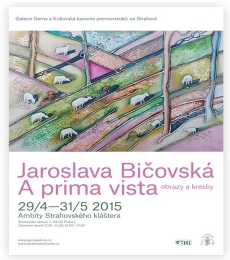
Jaroslava Bičovská: A prima vista, 2015
| Curator: | Linda Sedláková |
|---|---|
| Venue: | Ambity Strahovského kláštera, Strahovské nádvoří 1, Praha 1 |
| Dates: | 29. 4. - 31. 5. 2015 |
| Contact: | www.galeriegema.cz |

| Curator: | Linda Sedláková |
|---|---|
| Venue: | Ambity Strahovského kláštera, Strahovské nádvoří 1, Praha 1 |
| Dates: | 29. 4. - 31. 5. 2015 |
| Contact: | www.galeriegema.cz |
The exhibition is organized in cooperation with the Gema Gallery and the Royal Canonry of the Premonstratensian Order in Strahov.
Open daily 9: 30-11: 30; 12: 00-17: 00
Jaroslava Bičovská
born August 12, 1945 in Brandýs nad Labem. Studies: SOŠV / VŠVH in Prague in the years 1960 - 1964.
Jaroslava Bičovská tended to graphics and drawing from the very beginning. She started at the Vyšehrad publishing house, first as an administrative worker and later as a technical and art editor. Here she began to illustrate her first books. But then she got married, lived in Brandýs nad Labem, devoted herself to maternity duties and suddenly lost all contact with Prague and art. She couldn't find a job after her Maternity leave for a long time, until she finally started inventing and drawing for the magazine ''Our Family'' very successful comics for children. They were even published in the children's magazine Osama in Syria for 1 year. Over the years, her interest turned more and more to free painting. In 1976, she built a small studio and decided to leave comics and devote herself fully to painting. However, the graduate of the graphic school learned it herself, so no one made it easier for her to take the first steps in mastering the new technology. She considers David Hockney and Hans Hartung to be his role models, whose paintings are designed on a line, which was very close to her - an essential artist.
Already the first figural paintings from the 1980s, in a very dark tone, depicting especially the figures of musicians and comedians, revealed the special dream world of Jaroslava Bičovská, oscillating between realism and abstraction. Almost hyperrealistic figures float in an abstract environment, trembling with impressions resulting from their activities. In the 1989 Jamsession painting, there is almost tangible music surrounding the depicted musicians. In the 1990s, the abstract lines in Bičovská's paintings took on a stronger breath, but the captivating atmosphere of the works remained. Musical motifs remained (Unison, Da capo, Silensio, Solo ...) because thanks to the pianist's mother, the music is very deeply rooted in Bičovská. In addition, the themes of action, movement and transformation appeared (Sprouting, Revelation, Sign, Evening ...). At that time, Bičovské also began to open a hitherto inaccessible world beyond the borders. Before the revolution, she got thanks to her marriage to Dr. Charif Bahbouh, CSc., Originally from Syrian, "only" to the Arab world - Syria, Lebanon and Algeria. The local culture got under her skin, especially calligraphy, which was very close to her (Record of a beautiful day, Visit to Damascus ...) In 1990 she and her husband founded Dar Ibn Rushd, a publishing house focused on publishing publications from the Arab world. Jaroslava Bičovská typographically edited and designed the covers, and illustrated many of them. When drawing, she uses a special technique, where she first engraves the drawings into paper, and then she reaches for the pencil and colors. The line seems too specific to her and she defies absolute realism by engraving.
After the year 2000, the color palette changed, perhaps partly due to the safe mastery of painting techniques, Bičovská chooses bright to bright colors. The new work is represented by small watercolors and canvases, which return to the border of abstraction and reality after a purely abstract period. They radiate the genuine joy of living, of seeing the beauty around them and the certainty of painterly. Bičovská captures everything close to it - the landscape around the river in Brandýs nad Labem, the castle park or its own garden. The exhibition cycle is complemented by a series of drawings from the so-called California daily, which was also published in books.
Linda K. Sedláková
Representation in collections:
National Gallery in Prague; Czech Museum of Fine Arts in Prague; National Gallery Seoul, South Korea; National Gallery Damascus, Syria; Česká pojišťovna, Prague; Frost collection California, private collections in Hamburg, Milan, Groningen, Copenhagen, Amsterdam and other public and private collections at home and abroad.